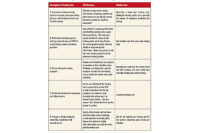Everyone in dairy companies, including corporate management, has increased their focus on food safety over the past two years.
Much of this focus has been driven by the Food and Drug Administration’s Food Safety Modernization Act (FSMA) which provides FDA inspectors with increased access to processing records, mandatory recall and product detention powers, and dairy plants’ “preventative measures” programs.
The detailed FSMA requirements for “preventative measures” that must be in written dairy plant operational programs are expected to be released soon, but were not ready as I wrote this. It is expected that these FDA requirements will be similar to requirements in the Global Food Safety Initiative’s (GFSIs) recognized third-party certification programs such as SQF, BRC, IFS, and FSSC22000.
How many resources (staff, equipment laboratory tests, etc.) do dairy companies and dairy plants need to dedicate to food safety programs to be FSMA-complaint, meet customer demands, achieve industry best practices and demonstrate due diligence? In other words, “When is enough enough?”
The answer lies with establishing a dairy product benchmarking system for food safety that provides easy-to-understand data that can compare key food safety indicators against target food safety goals. Such a system operates similar to a dairy company’s accounting system in that it measures and categorizes many things, consolidates the many measurements into simple-to-understand reports and then allows company and plant managers to compare the consolidated data to company or plant target values.
Just like a quarterly profit-and-loss financial statement allows management to make immediate adjustments in company finances, a food safety benchmarking program will allow these same company and plant managers to make quick adjustments to the amount and type of resources committed to food safety and avert costly product market withdrawals and public recalls.
A simple outline for such as system is listed below. This outline can be enhanced and expanded to address all important food safety criteria that affect dairy product safety and easily and objectively identify food safety gaps.
1. Establish time periods where the food safety benchmarking data will be consolidated for a report to corporate or plant management (weekly, monthly, quarterly, annually).
2. Identify key food safety criteria, including:
- Raw ingredients criteria (microbiological, temperature, pH, moisture content, etc. values)
- Process equipment cleaning (CIP, COP and manual), including start-up ATP swab results
- In-process measurements (temperature, pH and other food safety indicators)
- Processing issues (daily production levels, numbers of product changes per line, equipment breakdowns, raw material shortages, scheduling amendments, etc.)
- In-process product measurements (microbiological, temperature, pH, other food safety indicators)
- Environmental monitoring results (general bacterial levels, target microbial pathogenic levels)
- Internal plant audits as well as third-party, state and FDA food safety audit results
3. Establish categories for the ranges of data for each element within the criteria listed above. For example: “acceptable — low food safety risk,” “needs work — medium food safety risk” and “unacceptable — high safety risk.”
4. Assign numerical values to the ranges of data. For example: low risk is 10, medium risk is 5 and high risk is 1.
5. Add all numerical values for each food safety criteria. (See point #4, above).
6. Develop an on-going trend analysis that plots actual values for each food safety criteria against company and plant goals.
7. Failure to meet company and plant goals for at least two consecutive time periods (choose weeks or months) establishes a plant operational/personnel performance gap or a food safety resource gap. Identify the root causes and if a lack of food safety resources is the cause, immediately address.
8. Track all resources committed to food safety per plant on a weekly, monthly, quarterly and annual basis against plant food safety numerical values to develop correlations between resource inputs and food safety improvements (gap shrinkages).
In order to achieve acceptable and sustainable food safety performance, dairy companies and dairy plants must establish food safety criteria, develop measurements of the criteria, evaluate acceptability of these measurements against company and plant goals and adjust food safety resources accordingly. And they must do this not just at the end of each fiscal year, but as frequently as weekly and monthly. Only through this process of benchmarking of food safety can the dairy industry determine when “enough is enough” and effectively close food safety gaps.
Contact me for more details about food safety benchmarking.they can get their hands on, from metals to plastic, and sell it for scrap. Law enforcement is getting up to speed on the issue, and enforcement is active on the East and West Coasts.



